Spatiotemporal Dynamics and Drivers of Farmland Changes in Panxi Mountainous Region, China
Abstract
:1. Introduction
2. Overview of the Study Area
3. Materials and Methods
3.1. Data Resources
3.2. Study Methods
3.2.1. Land Use Transition Matrix
3.2.2. Standard Deviational Ellipse
3.2.3. Principal Components Analysis
3.2.4. Driving Forces Selection
4. Results
4.1. Farmland Changes in Panxi since 1990
4.2. Farmland Transfer Characteristics of Different Stages in Panxi Region
4.3. Farmland Dynamics across Different Terrains
4.4. Driving Forces of Farmland Change
4.4.1. The Roll-out of Farmland
4.4.2. The Roll-in of Farmland
5. Discussion
6. Conclusions
Acknowledgments
Author Contributions
Conflicts of Interest
References
- Yu, B.; Lu, C. Change of cultivated land and its implications on food security in China. Chin. Geogr. Sci. 2006, 16, 299–305. [Google Scholar] [CrossRef]
- Long, H.L.; Zou, J. Grain production driven by variations in farmland use in China: An analysis of security patterns. J. Resour. Ecol. 2010, 1, 60–67. [Google Scholar]
- Reidsma, P.; Tekelenburg, T.; Van den Berg, M.; Alkemade, R. Impacts of land use change on biodiversity: An assessment of agricultural biodiversity in the European Union. Agric. Ecosyst. Environ. 2006, 114, 86–102. [Google Scholar] [CrossRef]
- Qin, Y.W.; Liu, J.Y.; Shi, W.J.; Tao, F.L.; Yan, H.M. Spatial-temporal changes of cropland and climate potential productivity in northern China during 1990–2010. Food Secur. 2013, 5, 499–512. [Google Scholar] [CrossRef]
- Wang, Y.; Scott, S. Illegal farmland conversion in China’s urban periphery: Local regime and national transitions. Urban Geogr. 2009, 29, 327–347. [Google Scholar] [CrossRef]
- Thorson, J.A. Zoning Policy Change and the Urban Fringe Land Market. Real Estate Econ. 1994, 22, 527–538. [Google Scholar] [CrossRef]
- Abelairas-Etxebarria, P.; Astorkiza, I. Farmland prices and land use changes in periurban protected natural areas. Land Use Policy 2012, 29, 674–683. [Google Scholar] [CrossRef]
- Brady, M.; Kellermann, K.; Sahrbacher, C.; Jelinek, L. Impacts of decoupled agricultural support on farm structure, biodiversity and landscape mosaic: Some EU results. J. Agric. Econ. 2009, 60, 563–585. [Google Scholar] [CrossRef]
- Stoate, C.; Baldi, A.; Beja, P.; Boatman, N.D.; Herzon, I.; van Doorn, A.; De Snoo, G.R.; Rakosy, L.; Ramwell, C. Ecological impacts of early 21st century agricultural change in Europe to a review. J. Environ. Manag. 2009, 91, 22–46. [Google Scholar] [CrossRef] [PubMed]
- Stoate, C.; Boatman, N.D.; Borralho, R.J.; Carvalho, C.R.; De Snoo, G.R.; Eden, P. Ecological impacts of arable intensification in Europe. J. Environ. Manag. 2001, 63, 337–365. [Google Scholar] [CrossRef]
- Ackrill, R.; Kay, A.; Morgan, W. The common agricultural policy and its reform: The problem of reconciling budget and trade concerns. Can. J. Agric. Econ. 2008, 56, 393–411. [Google Scholar] [CrossRef]
- Wang, G.; Liu, Y.; Li, Y.; Chen, Y. Dynamic trends and driving forces of land use intensification of cultivated land in China. J. Geogr. Sci. 2015, 25, 45–57. [Google Scholar] [CrossRef]
- Zhu, H.Y.; Li, X.B.; Xin, L.J. Intensity change in cultivated land use in China and its policy implications. J. Nat. Resour. 2007, 22, 907–915. [Google Scholar]
- HAASE, D. Effects of urbanization on the water balance—A long-term trajectory. Environ. Impact Assess. Rev. 2009, 29, 211–219. [Google Scholar] [CrossRef]
- York, R. Demographic trends and energy consumption in European Union Nations 1960–2025. Soc. Sci. Res. 2007, 36, 855–872. [Google Scholar] [CrossRef]
- Poyatos, R.; Latron, J.; Llorens, P. Land use and land cover change after agricultural abandonment: The case of a Mediterranean mountain area (Catalan Pre-Pyrenees). Mt. Res. Dev. 2003, 23, 362–368. [Google Scholar] [CrossRef]
- Deng, W.; Fang, Y.P.; Tang, W. The strategic effect and general directions of urbanization in mountain areas of China. Bull. Chin. Acad. Sci. 2013, 28, 66–73. [Google Scholar]
- Ministry of Agriculture of the People’s Republic of China. Available online: http://www.moa.gov.cn/govpublic/ZZYGLS/201412/t20141217_4297895.htm (accessed on 15 June 2016).
- Li, J.; He, C.; Shi, P. Change process of cultivated land and its driving forces in Northern China during 1983–2001. Acta Geogr. Sin. 2004, 59, 274–282. [Google Scholar]
- Verburg, P.H.; Veldkamp, A.; Fresco, L.O. Simulation of changes in the spatial pattern of land use in China. Appl. Geogr. 1999, 19, 211–233. [Google Scholar] [CrossRef]
- Veldkamp, A.; Lambin, E.F. Predicting land use change. Agric. Ecosyst. Environ. 2001, 85, 1–6. [Google Scholar] [CrossRef]
- Veldkamp, A.; Verburg, P.H. Modelling land use change and environmental impact. J. Environ. Manag. 2004, 72, 1–3. [Google Scholar] [CrossRef] [PubMed]
- Zhang, X.Z.; He, F.N.; Li, S.C. Reconstructed cropland in the mid-eleventh century in the traditional agricultural area of China: Implications of comparisons among datasets. Reg. Environ. Chang. 2013, 13, 969–977. [Google Scholar] [CrossRef]
- Baja, S.; Arif, S. GIS-Based Modelling of Land Use Dynamics Using Cellular Automata and Markov Chain. J. Environ. Earth Sci. 2014, 4, 61–66. [Google Scholar]
- Nagendra, H.; Munroe, D.K.; Southworth, J. From pattern to process: Landscape fragmentation and the analysis of land use/land cover change. Agric. Ecosyst. Environ. 2004, 101, 111–115. [Google Scholar] [CrossRef]
- Pijanowski, B.C.; Brown, D.G.; Shellito, B.A. Using neural networks and GIS to forecast land use changes: A land transformation model. Comput. Environ. Urban Syst. 2002, 26, 553–575. [Google Scholar] [CrossRef]
- Waiyasusri, K.; Yumuang, S.; Chotpantarat, S. Monitoring and predicting land use changes in the Huai Thap Salao Watershed area, Uthaithani Province, Thailand, using the CLUE-s model. Environ. Earth Sci. 2016, 75, 1–16. [Google Scholar] [CrossRef]
- Ostwald, M.; Chen, D. Land use change: Impacts of climate variations and policies among small-scale farmers in the Loess Plateau, China. Land Use Policy 2006, 23, 361–371. [Google Scholar] [CrossRef]
- García-Frapolli, E.; Ayala-Orozco, B.; Bonilla-Moheno, M. Biodiversity conservation, traditional agriculture and ecotourism: Land cover/land use change projections for a natural protected area in the northeastern Yucatan Peninsula, Mexico. Landsc. Urban Plan. 2007, 83, 137–153. [Google Scholar] [CrossRef]
- Fernández-Romero, M.L.; Lozano-García, B.; Parras-Alcántara, L. Topography and land use change effects on the soil organic carbon stock of forest soils in Mediterranean natural areas. Agric. Ecosyst. Environ. 2014, 195, 1–9. [Google Scholar] [CrossRef]
- Dang, Y. The agricultural development of Hexi Corridor and its influence on ecological environment in historic times. Collect. Essays Cniness Hist. Geogr. 2001, 16, 114–126. [Google Scholar]
- Mottet, A.; Ladet, S.; Coqué, N. Agricultural land use change and its drivers in mountain landscapes: A case study in the Pyrenees. Agric. Ecosyst. Environ. 2006, 114, 296–310. [Google Scholar] [CrossRef]
- Venteris, E.R.; Slater, B.K. A comparison between contour elevation data sources for DEM creation and soil carbon prediction, Coshocton, Ohio. Trans. GIS 2005, 9, 179–198. [Google Scholar] [CrossRef]
- Li, Y.; Shao, J.; Zhou, G. Genesis Difference of Rocky Desertification in Karst Mountains-A Case Study of Panxian County, Guizhou Province. Sci. Geogr. Sin. 2007, 27, 785–790. [Google Scholar]
- Friedmann, H. The political economy of food: A global crisis. New Left Rev. 1993, 197, 29–57. [Google Scholar]
- McMichael, P. A food regime genealogy. J. Peasant. Stud. 2009, 36, 139–169. [Google Scholar] [CrossRef]
- Long, H.L.; Heilig, G.K.; Li, X.B.; Zhang, M. Socio-economic development and land use change: Analysis of rural housing land transition in the Transect of the Yangtse River, China. Land Use Policy 2007, 24, 141–153. [Google Scholar] [CrossRef]
- Jobbagy, E.G.; Jackson, R.B. The vertical distribution of soil organic carbon and its relation to climate and vegetation. Ecol. Appl. 2000, 10, 423–436. [Google Scholar] [CrossRef]
- Lu, Y.; Xu, Y.; Cai, Y. Analysis on Land Use/Land Cover Changes of Small Drain Basin Based on RS and GIS. Sin. Prog. Geogr. 2005, 1, 9. [Google Scholar] [CrossRef]
- Schneeberger, N.; Bürgi, M.; Hersperger, A.M. Driving forces and rates of landscape change as a promising combination for landscape change research—An application on the northern fringe of the Swiss Alps. Land Use Policy 2007, 24, 349–361. [Google Scholar] [CrossRef]
- Su, C.J.; Xu, Y.; Fang, Y.P. Bio-resource exploitation and ecological and environmental construction-Taking Panxi area as an example. J. Mt. Sci. 2004, 22, 143–148. [Google Scholar]
- Wang, X.G. Patterns and tactics for agro-economic development in ecotone—A case study from Panxi region in Sichuan province. Ecol. Agric. Res. 1994, 2, 24–30. [Google Scholar]
- Wang, F.L.; Zhan, T.P.; Chen, W. Advances in study of Nb-Ta ore deposits in Panxi area and tentative discussion on genesis of these ore deposits. Miner. Depos. 2012, 31, 293–308. [Google Scholar]
- The National Earth System Science Data Sharing Infrastructure. Available online: http://www.geodata.cn/ (accessed on 23 July 2016).
- Qiao, W.F.; Sheng, Y.H.; Fang, B.; Wang, Y.H. Land use change information mining in highly urbanized area based on transfer matrix: A case study of Suzhou, Jiangsu Province. Res. Geogr. 2013, 32, 1497–1507. [Google Scholar]
- Lefever, D.W. Measuring geographic concentration by means of the standard deviational ellipse. Am. J. Sociol. 1926, 32, 88–94. [Google Scholar] [CrossRef]
- Wang, L.C.; Gao, J. The Spatial Coupling Relationship between Settlements and Land-Water Resources in Zhangye Irrigation Districts. Ecol. Geogr. 2014, 2, 21. [Google Scholar] [CrossRef]
- Šmilauer, P.; Lepš, J. Multivariate Analysis of Ecological Data Using CANOCO 5; Cambridge University Press: Cambridge, UK, 2014. [Google Scholar]
- Liao, C.M.; Liu, Y.H.; Hu, B.Q.; Yan, Z.Q.; Zhou, X. Atlas analyses of karst l and rocky desertification and ecological rehabilitation model. Trans. Chin. Soc. Agric. Eng. 2004, 20, 266–271. [Google Scholar]
- Lu, Y.G.; Xu, Y.Q.; Cai, Y.L. Analysis on land us/land cover changes of small drain basin based on RS and GIS. Sin. Prog. Geogr. 2005, 24, 79–86. [Google Scholar]
- Wang, Q.; Zhang, T.B.; Yi, G.H.; Chen, T.T.; Bie, X.J.; He, Y.X. Tempo-spatial variations and driving factors analysis of net primary productivity in the Hengduan mountain area from 2004–2014. Acta Geogr. Sin. 2017, 37. [Google Scholar] [CrossRef]
- Sun, P.L.; Xu, Y.Q.; Wang, S. Terrain gradient effect analysis of land use change in proverty area around Beijing and Tianjin. Trans. Chin. Soc. Agric. Eng. 2014, 30, 277–288. [Google Scholar] [CrossRef]
- Luo, H.B.; Qian, X.G.; Liu, F.; He, T.B.; Song, G.Y. Ecological Benefit of Soil and Water Conservation in Hilly Areas by De farming and Reafforestation. J. Soil Water Conserv. 2003, 17, 31–34. [Google Scholar]
- Guo, J.M. Analysis on Population Distribution and Influencing Factors in Sichuan; Sichuan Normal University: Chengdu, China, 2014. [Google Scholar]
- Liu, M.; Hu, Y.M.; Chang, Y. Landscape change and its spatial driving force of farmlands in Wenchuan County of Minjiang River upper reach. Chin. J. Appl. Ecol. 2007, 18, 569–574. [Google Scholar]
- Chen, Z.; Lu, C.; Fan, L. Farmland changes and the driving forces in Yucheng, North China Plain. J. Geogr. Sci. 2012, 22, 563–573. [Google Scholar] [CrossRef]
- Yang, C.J.; Zhou, C.H. Investigation on classification of remote sensing image on basis of knowledge. Geogr. Territ. Res. 2007, 17, 72–77. [Google Scholar]
- Sun, J.B.; Liu, J.L.; Li, J. Multi-source remote sensing image data fusion. J. Remote Sens. 1998, 2, 47–50. [Google Scholar]
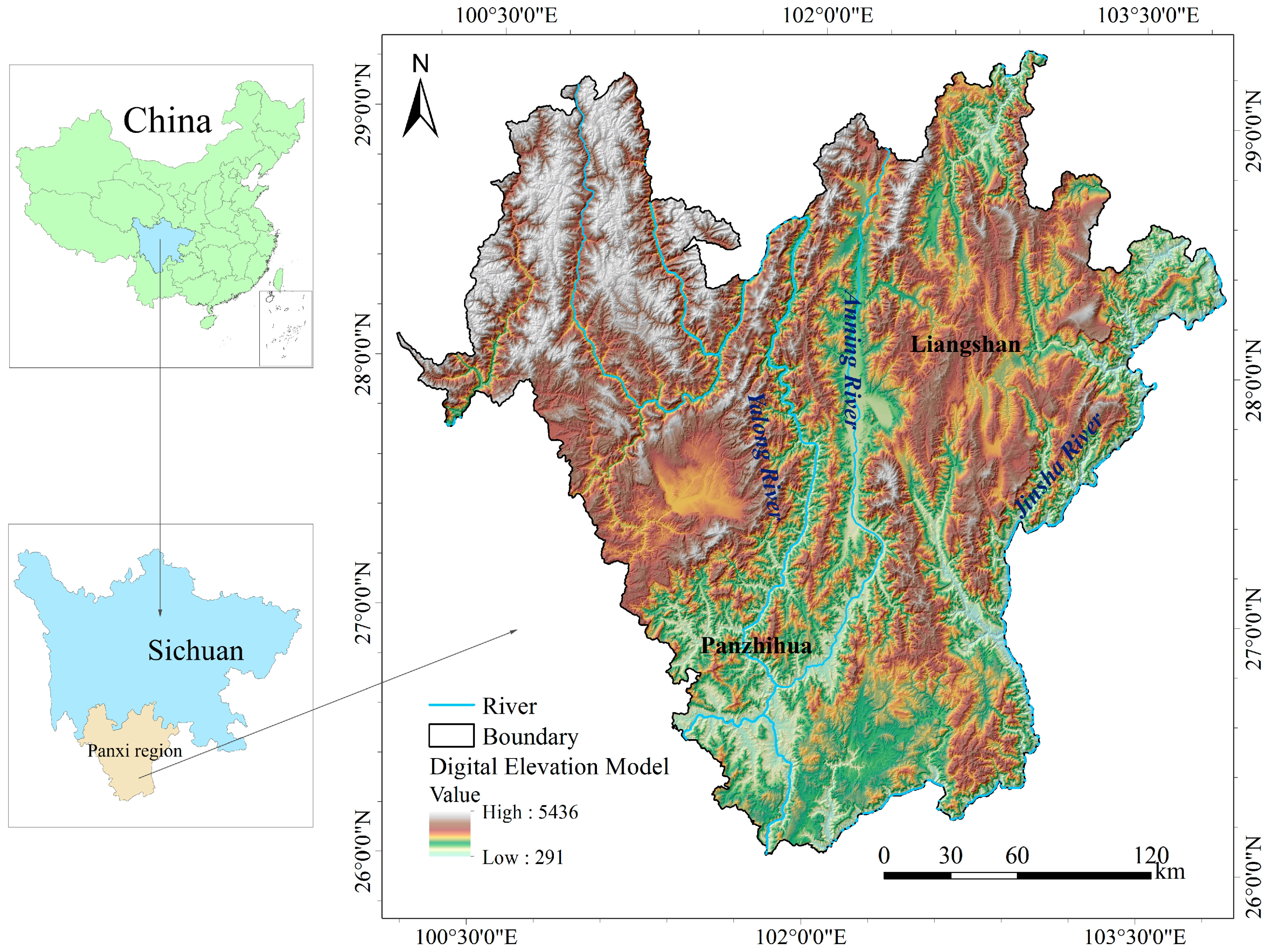

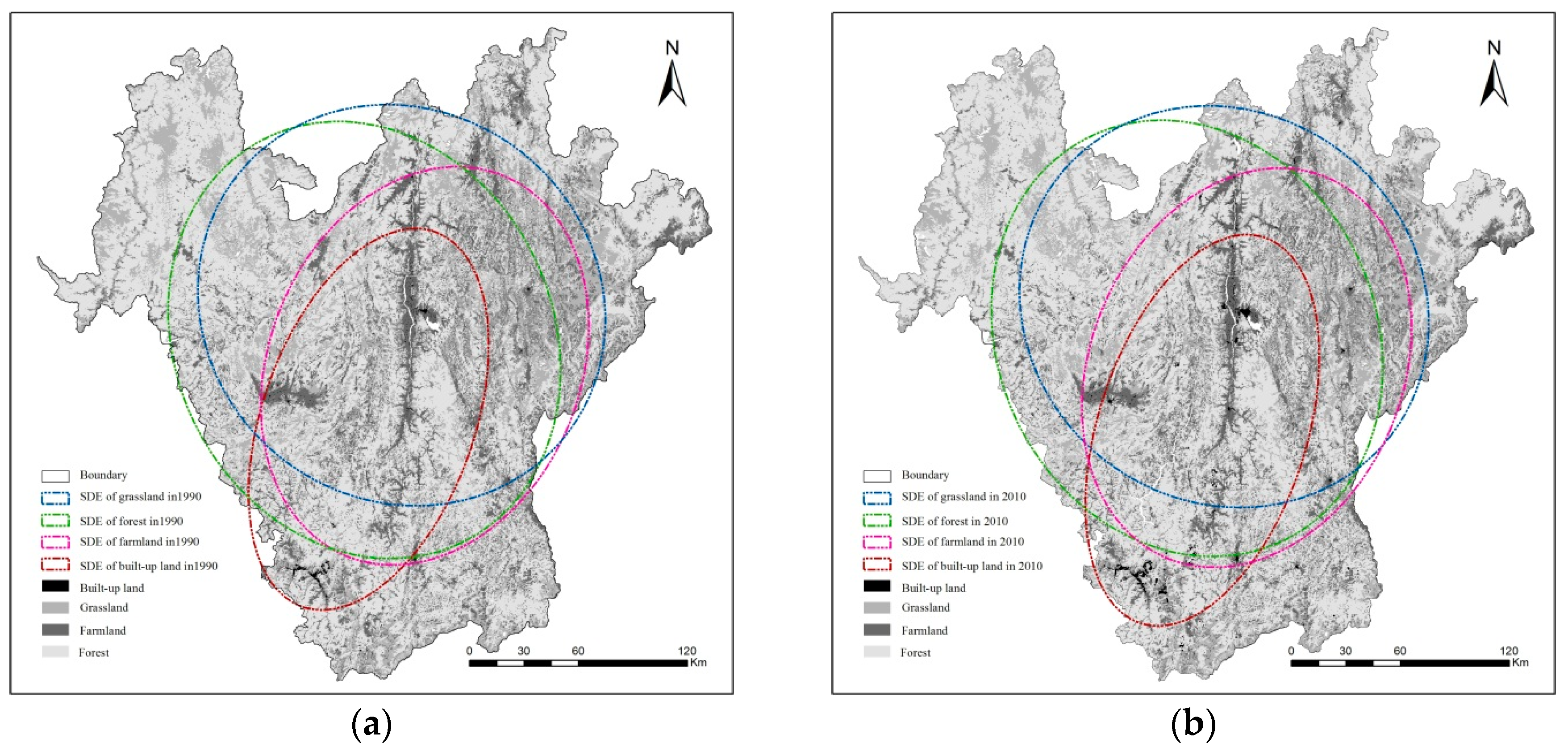
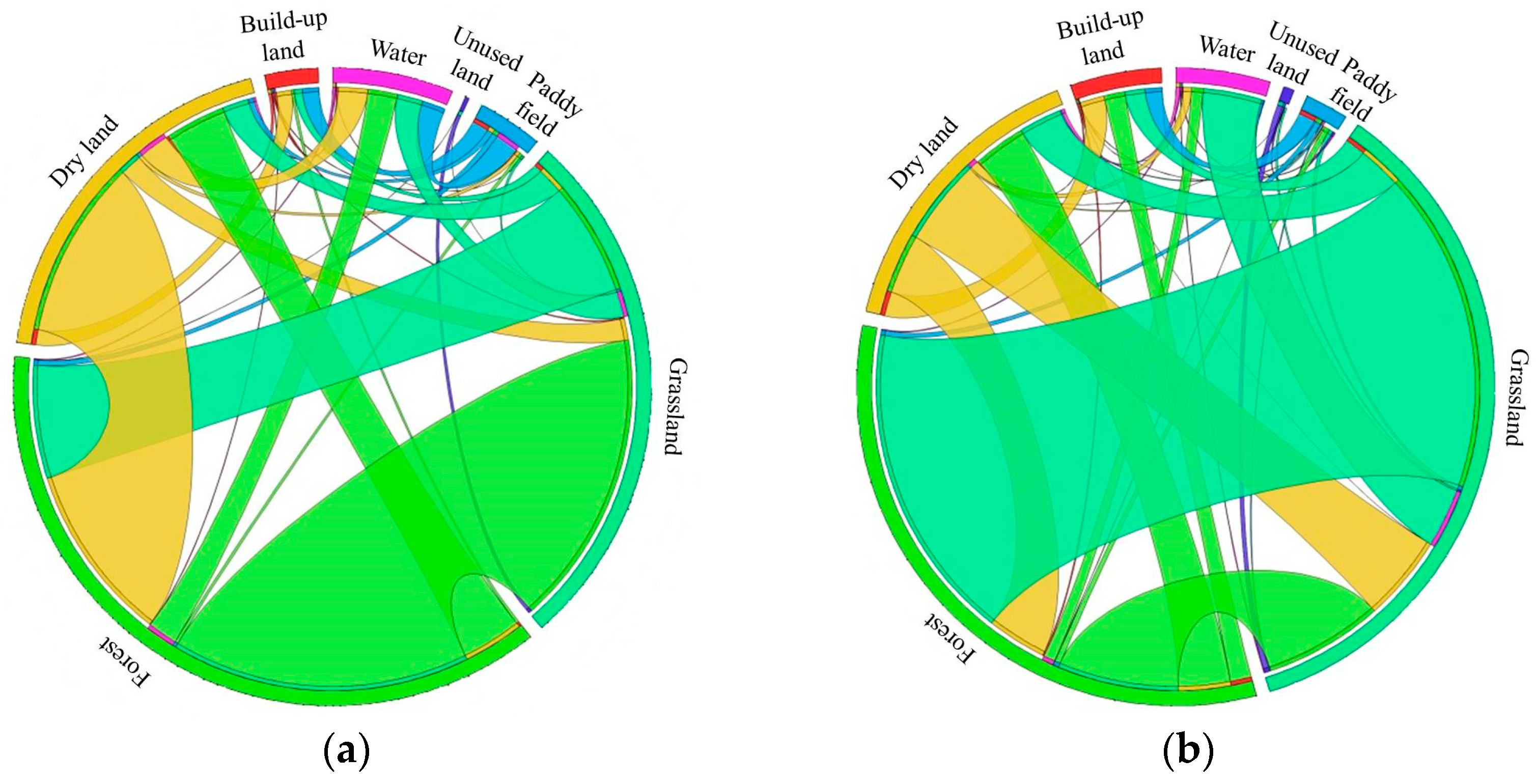
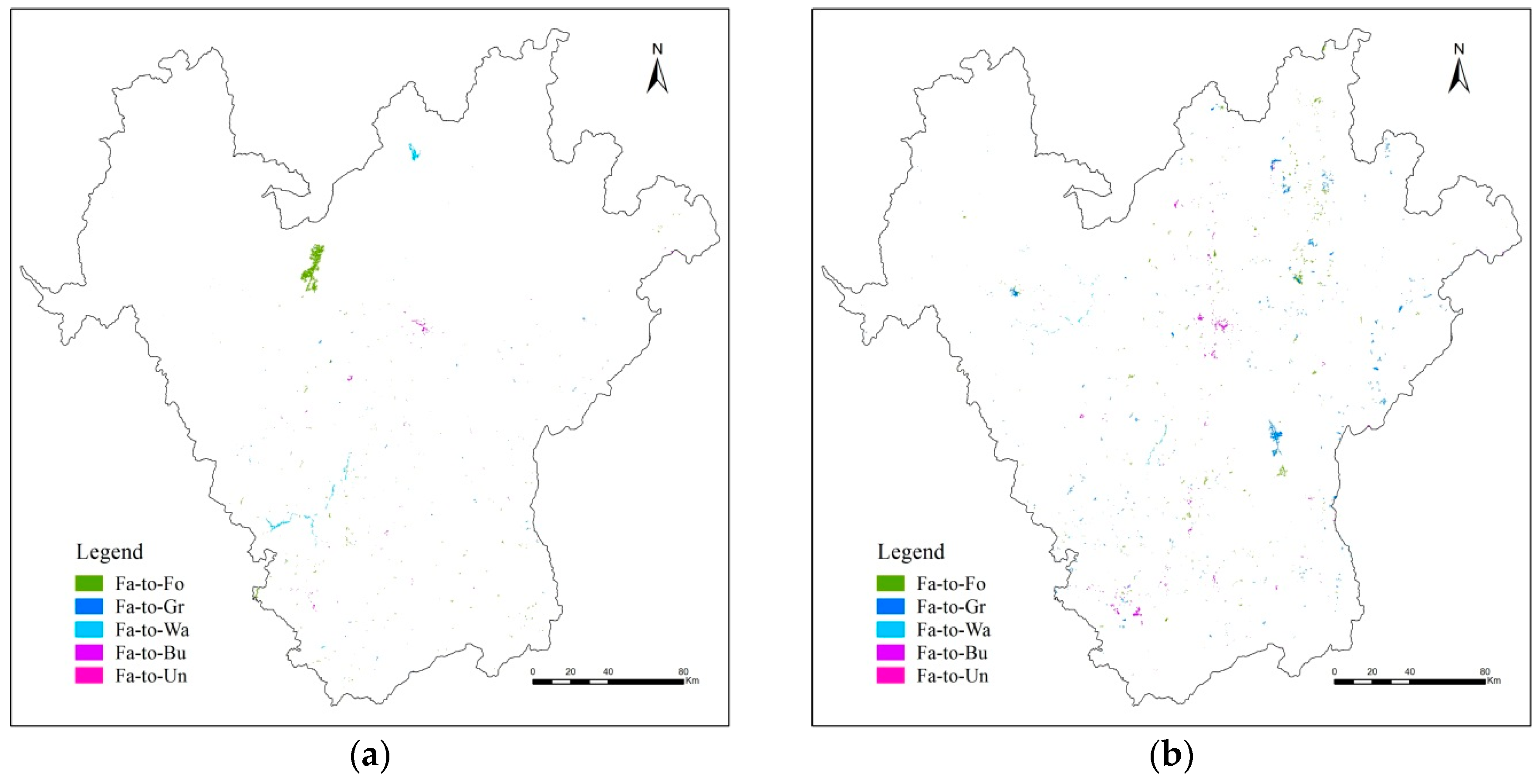

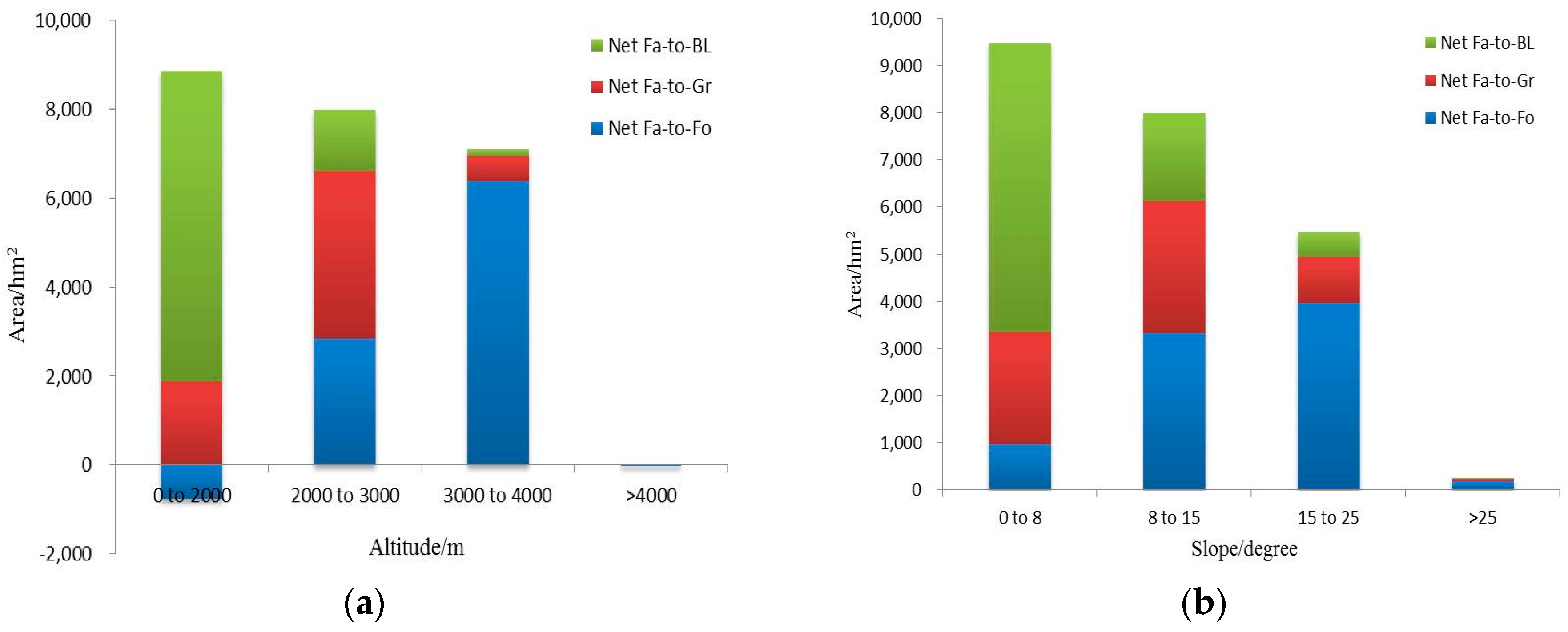
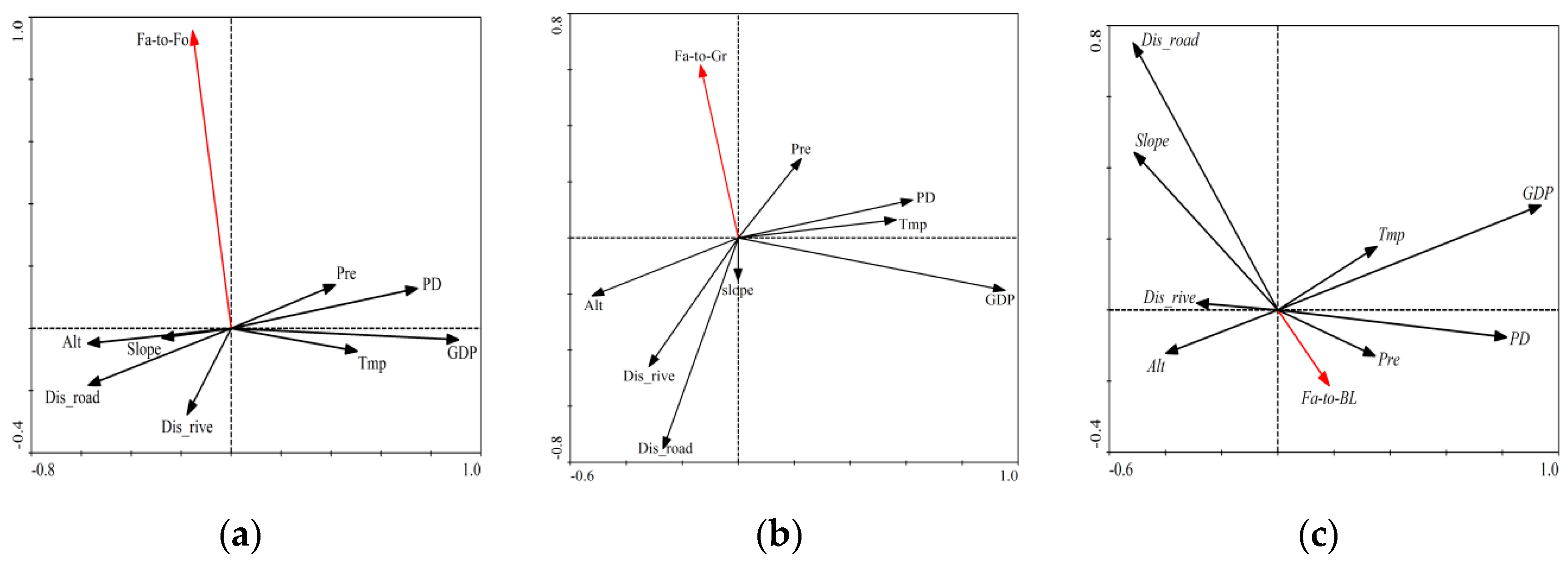
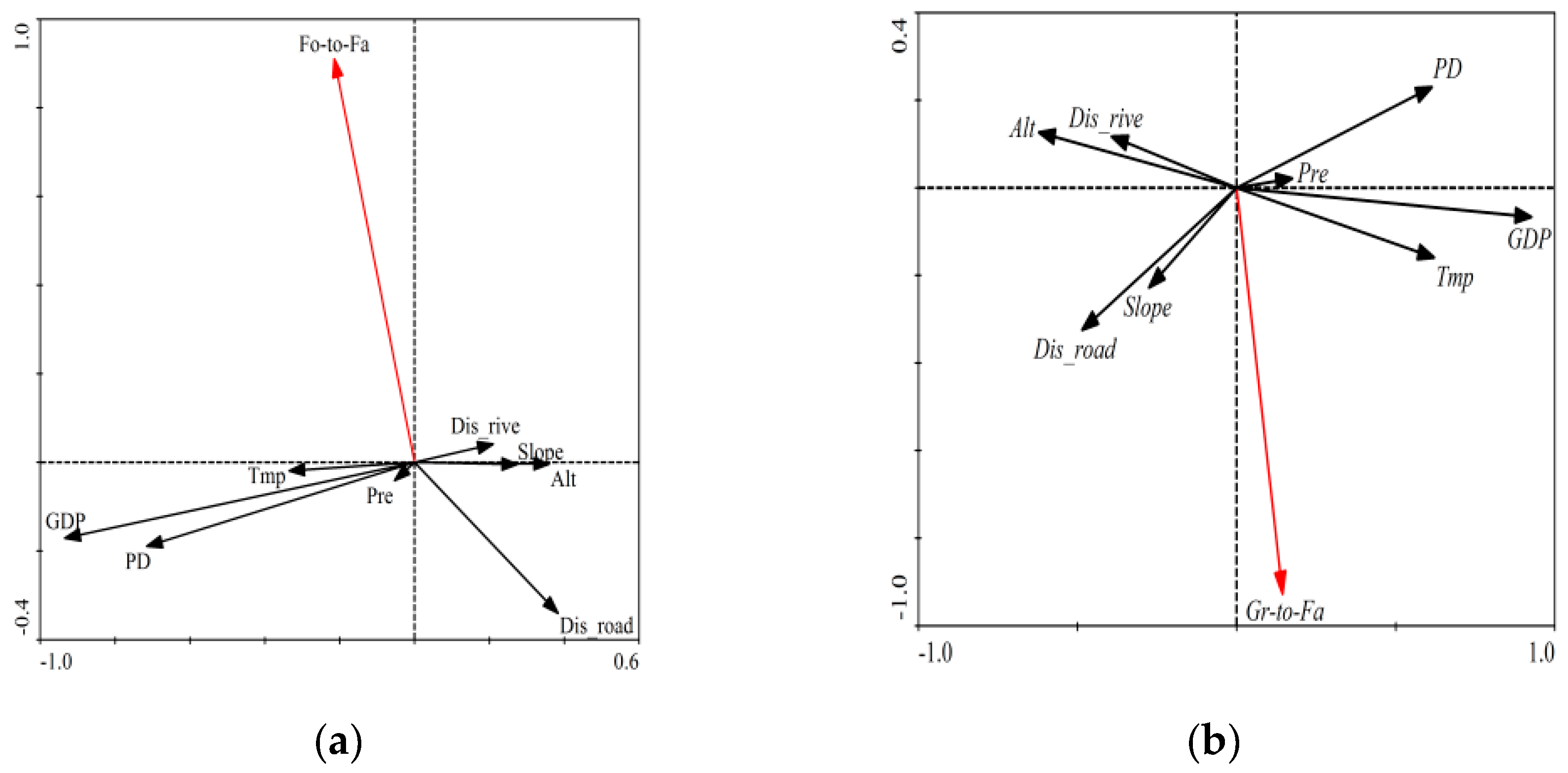
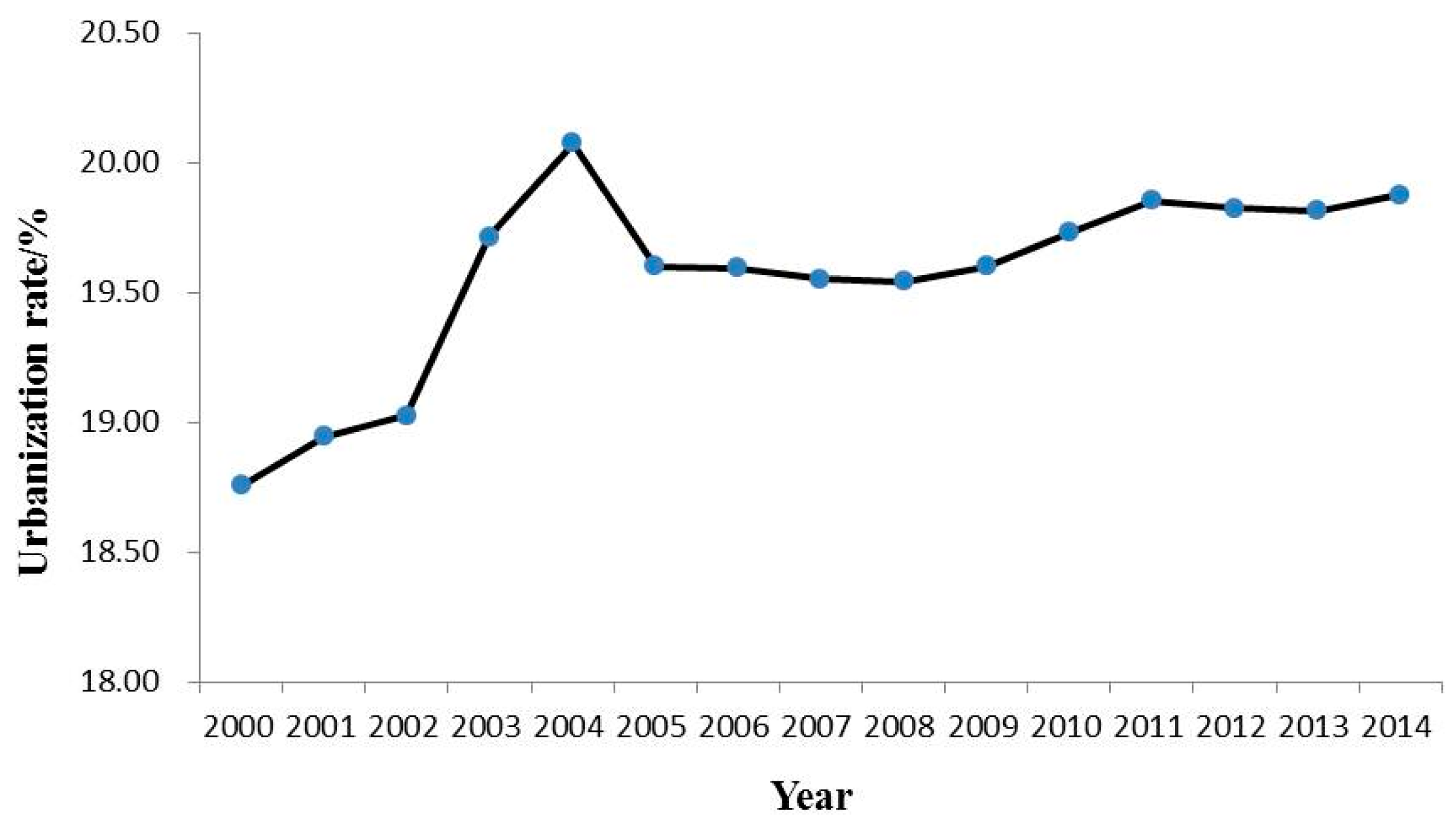
| Area | 1990 | 2000 | 2010 | Reduced Area 1990 to 2000 | Reduced Area 2000 to 2010 |
|---|---|---|---|---|---|
| Paddy field/km2 | 2126 | 2096 | 2073 | 30 | 23 |
| Dry land/km2 | 9708 | 9597 | 9448 | 111 | 149 |
| Total/km2 | 11,834 | 11,693 | 11,521 | 141 | 172 |
| 2010 | Paddy Field | Dry Land | Forest | Grassland | Water | Built-up Land | Unused Land | |
|---|---|---|---|---|---|---|---|---|
| 1990 | ||||||||
| Paddy Field | 0 | 6.401 | 15.457 | 1.7 | 19.609 | 40.742 | 0 | |
| Dry Land | 4.935 | 0 | 235.868 | 170.098 | 36.102 | 55.653 | 0.099 | |
| Forest | 12.355 | 136.811 | 573.644 | 414.928 | 43.431 | 41.549 | 0.582 | |
| Grassland | 8.88 | 91.107 | 663.75 | 717.188 | 129.596 | 43.419 | 3.17 | |
| Water | 0.945 | 5.828 | 2.021 | 1.827 | 10.34 | 0.687 | 0 | |
| Built-up Land | 1.084 | 2.484 | 0.297 | 0.524 | 1.727 | 2.09 | 0 | |
| Unused Land | 3.124 | 0 | 0.133 | 11.825 | 1.457 | 0 | 0 | |
| Year | Land Types | Angle | SDE-x | SDE-y | Ratio of y and x |
|---|---|---|---|---|---|
| 1990 | Farmland | 22.6 | 85,786.2 | 113,546.6 | 1.3236 |
| Forest | 154.5 | 124,007.6 | 104,297.8 | 0.8411 | |
| Grassland | 129 | 115,589.8 | 107,304.1 | 0.9283 | |
| Built-up land | 19.5 | 58,534.6 | 109,700.1 | 1.8741 | |
| 2010 | Farmland | 22.98 | 86,080.6 | 113,927.6 | 1.3235 |
| Forest | 155.1 | 123,551.9 | 104,295.3 | 0.8441 | |
| Grassland | 128.45 | 116,193.2 | 107,254.7 | 0.9231 | |
| Built-up land | 17.66 | 57,551.7 | 111,786 | 1.9424 |
| Year | 1990 | 2000 | 2010 | |
|---|---|---|---|---|
| Land Use Type | ||||
| Farmland | 93.10% | 86.50% | 65.04% | |
| Forest | 86.90% | 83.75% | 75.94% | |
| Grassland | 89.60% | 84% | 74% | |
| Water | 92.50% | 88% | 72.73% | |
| Built-up land | 89% | 91% | 85.19% | |
| Unused land | 89% | 87% | 70% | |
| Comprehensive accuracy | 90.02% | 86.70% | 73.82% | |
© 2016 by the authors; licensee MDPI, Basel, Switzerland. This article is an open access article distributed under the terms and conditions of the Creative Commons Attribution (CC-BY) license (http://creativecommons.org/licenses/by/4.0/).
Share and Cite
Peng, L.; Chen, T.; Liu, S. Spatiotemporal Dynamics and Drivers of Farmland Changes in Panxi Mountainous Region, China. Sustainability 2016, 8, 1209. https://doi.org/10.3390/su8111209
Peng L, Chen T, Liu S. Spatiotemporal Dynamics and Drivers of Farmland Changes in Panxi Mountainous Region, China. Sustainability. 2016; 8(11):1209. https://doi.org/10.3390/su8111209
Chicago/Turabian StylePeng, Li, Tiantian Chen, and Shaoquan Liu. 2016. "Spatiotemporal Dynamics and Drivers of Farmland Changes in Panxi Mountainous Region, China" Sustainability 8, no. 11: 1209. https://doi.org/10.3390/su8111209
APA StylePeng, L., Chen, T., & Liu, S. (2016). Spatiotemporal Dynamics and Drivers of Farmland Changes in Panxi Mountainous Region, China. Sustainability, 8(11), 1209. https://doi.org/10.3390/su8111209







